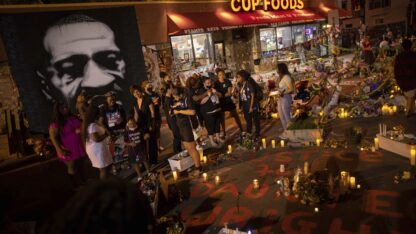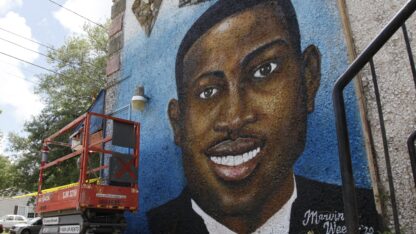The signs and footballs and handwritten notes that adorned the roadside memorial to Trayvon Martin could very well have ended up in the garbage.
It was March of 2012, the early days after the Black teenager’s shooting by a neighborhood watch volunteer named George Zimmerman. The protests had begun small, and then ballooned. So had the roadside memorial that a local historian named Francis Oliver started with just a couple of flower wreaths placed outside the walls of the gated community in Sanford, Fla., where Martin had been killed.
Within hours, flowers, teddy bears, sneakers and drawings of Trayvon Martin lined the sidewalk, as did bags of Skittles and cans of iced tea, the only things Martin was carrying during the fatal confrontation on Feb. 26, 2012. But then, Oliver recalled recently, the residents of the Retreat at Twin Lakes began to complain.
“The city manager called me,” Oliver recalled this week. “And he said, ‘Ms. Oliver, you’re going to have to take that memorial up.’ “
Oliver refused.
“I said they killed a boy and now they don’t want the flowers out there,” she remembers telling the town official. “Well, we pay taxes too.”
The next day, city workers cleared away the memorial. They did so each of the four times a new one popped up to replace the last. Rather than let the workers throw the mementos away, Oliver had them deliver the items to the little museum she had only recently opened, dedicated to the history of Goldsboro, an African American neighborhood in Sanford.
The items from Martin’s memorial deserved to be saved, Oliver reasoned, because they now formed an important part of the city’s Black history.
This was well before she or anyone knew that Martin’s killing would be the catalyst for a movement that would grow and evolve over a decade. It would start with the creation of Black Lives Matter, lead to the global uprising over George Floyd’s killing and culminate almost 10 years to the day after Martin’s death with federal hate crimes convictions for three white men who hunted down Ahmaud Arbery.
With the benefit of that hindsight, the items that Francis Oliver decided to save have taken on greater meaning — artifacts from the first days of a new racial justice movement that in a decade has profoundly recalibrated U.S. society.
Most of the items she saved are still in bins, stored in the Goldsboro Museum’s attic. But some of them Oliver and her niece, Tosha Baker, have on display in the museum’s welcome center. There’s a painting of Trayvon Martin, and T-shirts and banners bearing early versions of the slogans that have since become the lexicon of the marches that regularly take over U.S. streets: “No Justice, No Sleep” and “The Whole Damn System is Guilty.” There are binders full of letters and drawings from mourners who just wanted to pay their respects.
Oliver does not have big plans for the items. She said she wants only to save them, for the sake of history.
“Thirty, 40, 50 years from now, the stuff will be preserved,” she said. “The legacy of Trayvon Martin is going to be like the legacy of Emmett Till. It’s going to still be on T-shirts, on posters, and in rallies.”
He was a pioneer for the movement that succeeded him, Oliver said.
“A trailblazer,” she called him, with a small bit of his legacy preserved in the items she refused to let be thrown away.
Copyright 2022 NPR. To see more, visit https://www.npr.org.
9(MDAxODM0MDY4MDEyMTY4NDA3MzI3YjkzMw004))
For a deeper exploration of Ahmaud Arbery’s story, listen to WABE’s podcast, “Buried Truths.” Hosted by journalist, professor, and Pulitzer-prize-winning author Hank Klibanoff, season three of “Buried Truths” explores the Arbery murder and its direct ties to racially motivated murders of the past in Georgia.

9(MDAxODM0MDY4MDEyMTY4NDA3MzI3YjkzMw004))








